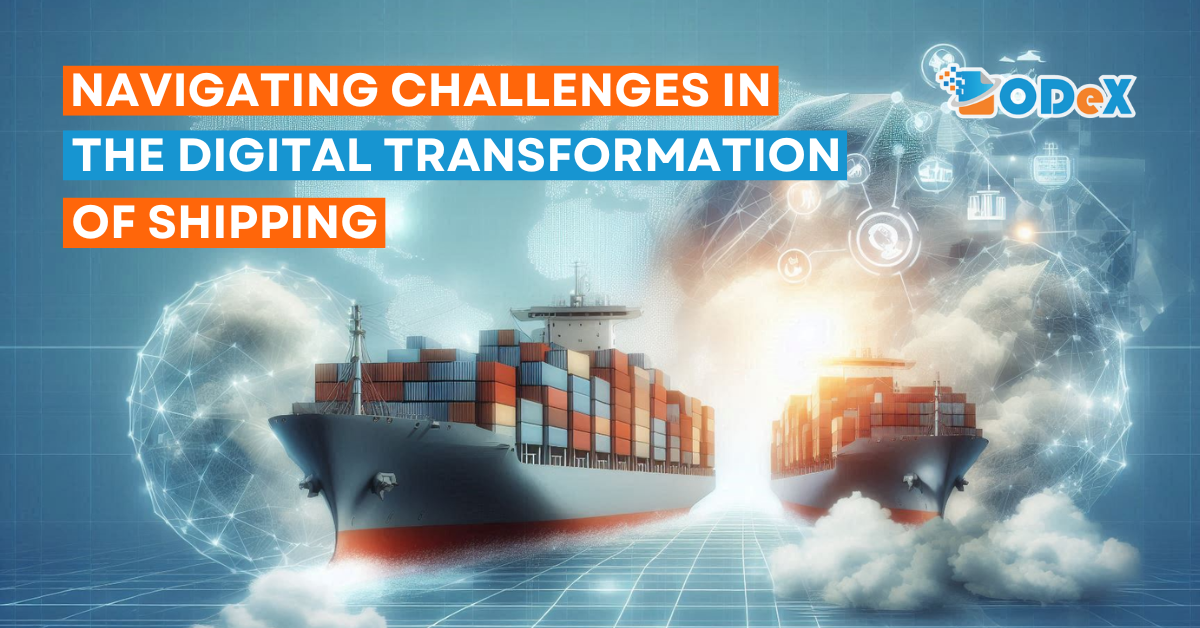Navigating Challenges in the Digital Transformation of Shipping
Introduction
The shipping industry, which has been historically dependent on paper-based processes and manual operations, is experiencing a much-needed shift toward digital transformation with the aim to enhance operational efficiency, increase transparency, and facilitate better collaboration among stakeholders.
However, the process of digitalization is not without its challenges and in this article we explore the key obstacles the shipping industry faces in its digital transformation journey and potential solutions to overcome these hurdles.
Challenges in Digital Transformation
1. Resistance to Change
One of the primary challenges in the digital transformation of the shipping industry is resistance to change. Many stakeholders, including shipping companies, customs brokers, and freight forwarders, have relied on traditional methods for decades. Adapting to new digital systems requires a significant shift in mindset, alongside substantial training and adjustment periods and digitalisation brings along with it the worry about job losses.
2. Data Security and Privacy Concerns
With the rise of digital platforms, concerns about data security and privacy have become more pronounced as the shipping industry deals with a wealth of sensitive information, including shipment details, financial transactions, and personal data. Ensuring that this information is protected from cyber threats is paramount.
3. Interoperability Issues
The shipping industry involves a multitude of stakeholders, each utilizing different systems and technologies. Achieving seamless interoperability between these disparate systems is a significant challenge. Without interoperability, digital transformation efforts can lead to fragmented processes and inefficiencies.
4. High Initial Investment
The cost of implementing some of the digital solutions can be prohibitive for many companies, particularly small and medium-sized enterprises (SMEs). The expenses associated with acquiring technology, training staff, and maintaining systems can be substantial, creating a barrier to entry.
For example, McKinsey reports that leading logistics companies have seen operational improvements of 10-20% in the short term and 20-40% within two to four years after investing in digital tools. This indicates that while the initial investment is high, the returns can justify the expense.
5. Regulatory and Compliance Challenges
The shipping industry is heavily regulated, with stringent compliance requirements. Navigating these regulations while implementing digital solutions can be complex. Ensuring that digital platforms comply with international shipping standards and regulations is essential.
6. Technical Skill Gaps
The successful digital transformation of the shipping industry requires a workforce with the necessary technical skills to operate and maintain digital systems. However, there is often a gap between the skills required and those available within the industry.
Tech talent shortages will cost organizations $5.5 trillion by 2026, according to IDC market research which surveyed 811 enterprise IT leaders in the U.S. and Canada.
7. Integration of Legacy Systems
Many companies in the shipping industry still rely on legacy systems that are not designed for digital integration. Upgrading or replacing these systems can be costly and time-consuming, posing a significant challenge to digital transformation.
8. Scalability Issues
As companies grow, their digital solutions need to scale accordingly. Ensuring that digital platforms can handle increased volumes of data and transactions without compromising performance is crucial.
Potential Solutions
User-friendly digital platforms developed with customer experience in mind that can simplify the transition from traditional methods can address resistance to change issues effectively. Comprehensive training and support can ensure that stakeholders are comfortable and confident in using new digital tools. Demonstrating tangible benefits, such as reduced paperwork and faster processing times, can help in overcoming resistance.
Data security and privacy concerns can be mitigated by implementing robust security measures, including encryption, secure access controls, and regular security audits.
Creating a unified digital platform like ODeX that integrates various systems used by stakeholders can promote collaboration and efficiency. An API-based architecture can allow for smooth integration with other software, ensuring seamless data exchange and workflow management.
Ensuring the scalability of digital platforms through flexible pricing models allows companies to expand and adopt new technologies without facing technological bottlenecks.
Digital platforms must be designed to comply with industry regulations and standards. Continuously updating features to align with new regulations can ensure that users remain compliant. Automating compliance processes can reduce the burden on stakeholders and minimize the risk of non-compliance.
Providing extensive training and support can help stakeholders develop the necessary technical skills. An intuitive design of digital platforms can reduce the learning curve, making them accessible even to those with limited technical knowledge.
Conclusion
The digital transformation of the shipping industry is a complex but necessary journey. By addressing challenges such as resistance to change, data security, interoperability, and regulatory compliance, the industry can move towards enhanced efficiency, transparency, and collaboration.
Embracing digital transformation is key to staying competitive and meeting the demands of a rapidly changing global trade environment.
As the shipping industry continues to evolve, the successful implementation of easy to use, digital solutions like ODeX will be crucial for future growth and sustainability.
By focusing on these potential solutions, stakeholders can navigate the challenges of digital transformation and unlock the full potential of digitalization in the shipping sector.
Overall, while the financial investment required for digital transformation in the shipping industry is substantial, the potential benefits in terms of cost savings, efficiency improvements, and competitive advantage make it a worthwhile endeavor.


















